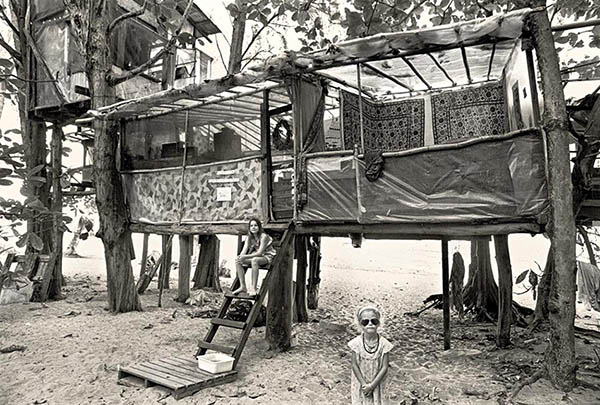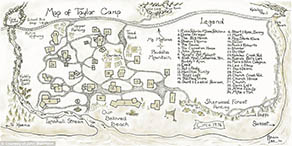 |
 |
 |
|||||
"Taylor Camp, Hawai‘i:
|
"In most societies settlement and subsistence are closely related. People choose to live close to where they hunt, plant, for for that matter work at a 9 to 5 job. This was certainly the case with the Hawaiian settlements, historic as well as prehistoric, that we excavated at Hā‘ena…. "The Taylor Camp occupation contrasted markedly with this Hawaiian pattern. This may have been partly due to the series of events that led to the founding of the camp, but more importantly it was due to the kind of economy that supported the people living at the site. 
"Taylor camp was not a planned community. The land on which it was built had been loaned for use by Howard Taylor, a Kauai resident, to a small group of people (estimated at from 17 to 22 souls) who had been squatting at several of the county parks on Kauai during 1968 and 1969. The county police had shooed the group from one park to another and the county was taking legal action against them when Mr. Taylor offered them the use of a small parcel of land bordering the beach at Hā‘ena point. "Taylor Camp began as a series of tents, but quickly transformed itself into a set of more permanent structures as tents rotted and the inhabitants saw some possibility of permanent residence on the land. "By 1972 there were 21 permanent houses at Taylor Camp. All of them were tree houses since local authorities would not issue them permits for ground dwellings. Some of these structures were quite elaborate indeed, with large bamboo pole foundations, clapboard siding, and windows facing the sea. In addition to the houses in the camp there was a communal shower, an open air toilet, a small church, and even a cooperative store which operated on and off until the camp's closing. "Because Taylor Camp was not a planned community, there was no consistent theme to its growth, but the camp's size was curtailed when, under subtle coercion from the community asked that no more houses be built on the land. "The limits of Taylor Camp's growth put certain stresses on the community, but also permitted the development of a permanent structure to the settlement. The best and most substantial houses were next to the beach. About 50 meters back from the beach were several other houses constructed on the long-abandoned irrigated taro terraces. A community trail bisected the camp and led back through a parking lot area to the Kuhio highway, the main road that connects the north end of Kauai to Hanalei, the nearest town some seven miles to the east. 
"The church appears to have been located on the west side of the camp close to the cooperative store. Near what must have been the center of the camp was the communal toilet, an open air "throne" mounted next to a concrete septic tank (a requirement of the local Department of Health) as well as the shower, a contraption ingeniously rigged from 55 gallon oil drums. A special attraction of Taylor Camp was the sauna constructed sometime before 1972 near the beach on the east boundary of the community. On the west side of the camp were the gardens, about two acres in extent, which are still producing a few vegetables today.... "What primarily interested us was how the inhabitants of Taylor Camp supported themselves. The placement of the community in such a remote area of Kauai seemed to leave two option open to community members. The first was to attempt to establish a local resource base very much like the native Hawaiian subsistence…. 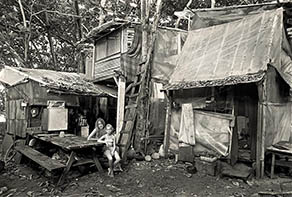
"The second option was to tie the support of Taylor Camp into the local cash economy of Kauai. It seems that the majority of Taylor Camp residents chose the latter option, although an informant survey that we conducted as part of our research produced a wide range of opinion about the economy of the camp and the way that its residents supported themselves." "Many local Hā‘ena residents claimed that the economy of the camp was based on welfare support from county and state and on the production and sale of Cannabis sativa, which Hawaiians call pakalolo ("crazy weed") and we often call marijuana.
|
"One of our informants who had lived in the camp from 1972 until it was closed disagreed. He stated that Taylor Camp was like any other community in the U.S. The majority of its residents worked at various jobs on Kauai and considered the camp an inexpensive and comfortable place to live. Some grew pakalolo for sale or home use, and a few were on welfare. But according to this informant there were no more people supported by welfare in Taylor Camp than in the community at large. "Another resident who had lived there fore the last two years of the camp's existence seemed to contradict our first informant. He claimed that you could tell when the welfare checks came in because 'everybody was drinking Heineken's.' He also claimed that the camp was in his words 'wired to Ching Young's store.' Ching Young's was the local general merchandiser located in Hanalei. 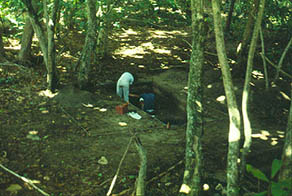
"Our initial research at Taylor Camp tells us little about whether the camp was dependent on 'welfare' or food stamps for its maintenance, but it does support the view that it was 'wired to the general store.' Two massive trash pits were located in the garden area to the west of the camp. These were filled with glass and metal trash, all of which reflected a heavy dependence on the cash economy of our society. "Several smaller trash pits in the camp were filled with commercial containers for everything from spices to tinned luncheon meats. The small amounts of garbage that we collected from the upper levels of the site in the course of our excavations into the earlier Hawaiian components showed little or not use of resources such as the local limpet called opihi, or strombus shell. These shellfish are abundant in the area today and appear to have been among the chief inshore resources used by the earlier Hawaiian settlers at Hā‘ena. Taylor Camp residents, however, don't seem to have had an interest in the resources of the sea. "Our excavations in one particular 2X2m square at the site produced an interesting contrast in economy. The deep Hawaiian layers here produced thousands of grams of garbage, including shell, fishbone, pig and dog bone and even fish scales. A pit from the Taylor Camp period, on the other hand, yielded rotten tent fabric, metal grommets, a tab top from an aluminum beer or pop can and an empty tin of sardines that had been packed in Maine. 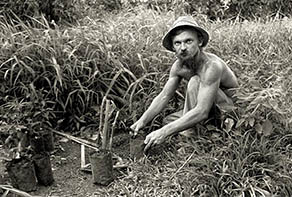
"The small size of the garden area—a little less than two acres—demonstrates that planting played a secondary role in the subsistence of Taylor Camp residents. "The large amounts of metal and glass trash, and the fact that the garden area of the camp, even during its most intense planting, couldn't have supported even one-fourth of the residents of Taylor Camp, both suggested to us that the camp, despite its isolation, had to be dependent on a traditional American cash economy." "Besides these, a major sign of the dependence of Taylor Camp on the outside is the number of abandoned cars that still pepper the landscape at the margins of the main camp. We counted at least 26 cars, most of them stripped of usable parts. The vast majority of these vehicles, if we can believe our informants, were left behind by Taylor Camp residents. Most were older models that had apparently died natural deaths in the camp parking lot. We were told by one former camp resident that if a car died even temporarily 'it was a goner.' It would be stripped of most usable parts by other camp residents and local outsiders in order to keep their own cars running. A working automobile was a valuable asset since it provided access to the general store as well as mobility for those who either worked in conventional jobs or grew their pakalolo in isolated areas far removed from the camp. 
"The sheer number of these vehicles within the confines of the camp leads to the inference that Taylor Camp was almost completely tied in with the cash economy of the island. The importance of automobiles in Taylor Camp, as isolated as it seemed to be from the rest of Kauai, reflects the importance of automobiles to American society at large. The residents of the camp shared an American need for mobility. They do not seem to have reflected the earlier Hawaiian lifestyle represented in our excavations there so much as they were unaware of the potentials that the sea and land offered them. "Several informants that we talked to who were residents of the camp stressed the idea that they considered themselves to be living close to the land while they were at Taylor Camp. The archaeological remains that we mapped and uncovered there to suggest to use that their perceptions of being close to the land included isolation from the main centers of trade and commerce on Kauai rather than dependence on the land for subsistence."
|
"Taylor Camp was a somewhat bizarre settlement in the eyes of local residents of Hā‘ena. Its residents often sunbathed in the nude, and some preferred to go about their daily activities without the benefit of clothing. Their church, called the Church of the Brotherhood of the Paradise Children, welcomed Christian, Buddhist, Jew, and atheist alike. Worshippers shared experiences of God, the sun, or the mystical power of the pyramids. There were no police in the camp and community members attempted to maintain order by good judgment, common sense, and community meetings. 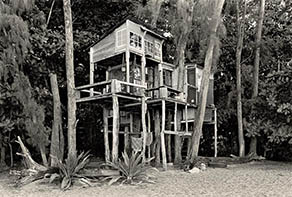
"Taylor Camp was altogether unlike the outside community in its lack of bureaucratic structure. While the size of the community was constrained by the number of structures, there was a large transient population associated with the camp. These visitors stayed sometimes for a few days, and often for longer periods. A few of them managed to become community residents as older members left and "willed" a transient or friend from the mainland a house or room in one of the spacious tree houses. "The large number of mainland visitors to the sparsely inhabited north end of Kauai, the lack of participation of camp members in community affairs and structures, the nudity, and of course the presence of 'drugs' all contributed to the suspicion with which the older, more fixed residents of Hā‘ena viewed Taylor Camp. "At the same time, our initial excavation and survey there suggested to us that Taylor Camp was well within the mainstream of the American value system. A tremendous value seems to have been placed upon mobility in the form of the automobile. The subsistence of the camp was based on a cash economy that required considerable monetary inputs rather than on a regime of planting and fishing. In terms of its support system at least, the camp was little different in orientation from the far flung bedroom communities of the large metropolitan centers of America. 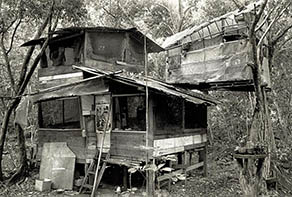
John and Marie's House, 1976. Photo courtesy of John Wehrheim. "There were, of course, certain major differences. The residents of Taylor Camp were apparently younger than the average middle class suburbanite, and it is likely that they had smaller and fewer families to support. But like most American suburbanites they chose a lifestyle that was comfortable to them and then went to considerable pains to maintain it, even though it meant long treks for work, shopping, and leisure activities. There is little doubt that the form that Taylor Camp took would have been impossible without the automobile, and that cash, whether derived from the illicit sale of drugs, welfare fraud, or hard labor played an important part in the success of the community. "Taylor Camp was an experiment in living in the late twentieth century that was spawned by an attempt at rejection of many of contemporary America's superficial values. But it was an experiment in alternative leisure styles rather than a Utopian settlement designed to explore the economic and organizational frontiers of human settlement. It existed within a fixed and commonly accepted value system that emphasized mobility and depended on a cash economy. Its history and growth can give us some new insights into the way that frontier communities develop in the twentieth century within our own cultural matrix and the basic value systems of a number of people in our society who attempted, for a variety of motives, to develop their own community structures and living styles…."
|
